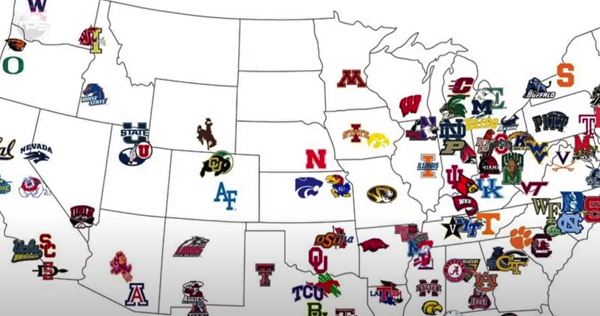
In the realm of statistical analysis, it could have been named the “Tyus Edney effect” to describe the exact point in the timeline which tripped a series of casual events leading to the modern ecosystem of college athletics. The diminutive UCLA guard almost encountered both coasts simultaneously in scoring a stunning improbable layup to spark the Bruins to the 1995 NCAA basketball title, a team which featured the now iconic Ed O’Bannon, and the figurehead for the subsequent precedent setting legal battle leading to scholarship athletes being able to profit off of their image, name and likeness (NIL). Edney’s heroics jolted the UCLA with a Red Bull-vodka shot (a Touchdown) to the kings of March Madness, and gave O’Bannon the primetime stage to launch his crusade.
If not for the 5’10 94-foot frenetic sprint to beat the Missouri Tigers, themselves now the answer to a great bar trivia question, would O’Bannon had the opportunity to start the wheels in motion to a reasonable conclusion in an age of chaos. Historic parable aside, with the marriage of the SEC and ESPN official, and the willing bridesmaids of Oklahoma and Texas culminating the gratuitous civil union of a power couple, how does the remaining single’s scene of the tenuous dating ladder survive long enough to procreate and sustain a diverse array of athletics spanning the spectrum from football to women’s field hockey.
In the most recent stirring developments, the leadership of the ACC, the Big-Ten and the Pac-12 announced an alliance, which in the words of author James Clavell, “changes nothing, but changes everything.” Besides the executives at CBS plotting in own legal battle in attempting to trademark the term “alliance”, as if Survivor is still relevant after 25 years, the 41 institutions are apparently planning various mergers and in the interim, interlocking non-conference schedules. Of course the issue is always the television contracts, and the propensity of networks to strongarm and relentlessly impose their will until courtroom fees reach a critical mass, and currently no athletic will consider absorbing the tens of millions of dollars needed to dissolve a deal. With finances already precarious, especially for schools in smaller media markets, the reality of any the intriguing ideas of the alliance coming into fruition will not be until at least 2026, which leaves the powers that be with tough decisions to be made.
As the crafty innovative minds of the SEC have forged a nearly perfect mechanism of athletic and business fusion that meets the basic academic expectations according to presidents at the traditional renowned institutions of lecture hall achievement, the blueprint for success remains open sourced, however it is not attainable due to the constraints of standards. The mecca of major sports is able to skirt the stigma of “football factories” in milking the Vanderbilt factor for all its worth, and playing off the prestige of one of the nation’s finest universities. The school also provides a soft target for the big names of the league as in most years the football team is a loveable doormat that has never reached double digit victories for a season in its history. Combined with infuriatingly tepid quartet of non-conference games on the schedule, the heavyweights realize a natural advantage and enjoy an extended margin for error compared to the generally tumultuous minefields endured by the 41 programs on the outside looking in. As the dear leaders of the Big-Ten and the Pac-12 allegedly prefer masochism over tangible results, both leagues leave their members vulnerable with rigorous nine game conference slates, and scheduling methods that are possibly corrupted with elements of the International Olympic Committee track suit donning mob recognition directive.
While the current organizational infrastructure of the special 41 is not conducive to sustained success in fostering universal parity, partisan politics and the puppet masters of Democratic ideology have unfortunately severely compromised any opportunity to correct the fundamental issues that plague the entire spectrum of scholarship athletics. This reprehensible phenomenon is especially prevalent on the West coast, as Title IX is so ingrained within the conscience of lawmakers, that football, making every other sport possible, is viewed with a toxic distain. Even with the hype surrounding the pending alliance, due to the chaotic organization dynamics of placing future of the planet in the stubby arms of dinosaurs in changing the trajectory of an earth killing meteorite, the gesture in trying to even the playing field seems empty.
With the ESPN-SEC pact light years ahead of the nearest middle America storied rivals, the pro-style approach to running an “amateur” megaconference enhanced by NIL’s leaves a dearth of solutions for the majority of universities which are not located within proximity to a bustling metropolis. Can the leadership of the 41 come to a consensus and cut ties with the SEC, or will politics continue to be a detriment to schools outside of Alabama and legendary coach in the making Nick Saban. Ironically, the Crimson Tide and the majority of schools in the conference are situated in smaller cities, yet enjoy dizzying success.
Outside of Clemson, Ohio State, and national brand name Notre Dame, now that Oklahoma and Texas have defected, the 38 other institutions exist at least a tier down in terms of periodically reaching a championship level, and this reality will only be exacerbated as programs desperately scramble to find some species of buoyancy.
Tyus Edney’s miraculous frenetic shot artistry is not merely an iconic video memory shared during the chords of “One Shining Moment” at the conclusion of the tournament, as the Bruin’s ascension to cutting down the nets in 1995 knocked the first perceptible crack in the windshield glass of student athletes and the eventual future shock nightmarish era of pay for play.